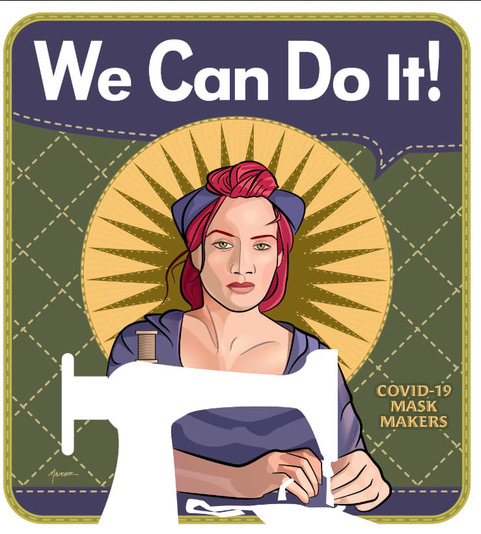Behind the Mask
History and Memories in Every Stitch

It was my sister who inspired me: She’s been a nurse for years; it’s not a job, it’s who she is. She lives, eats, and breathes to take care of others in need. And since she’s been battling Stage 4 cancer, she’s been sheltering in place longer than anyone. Although she cannot care for patients any longer, she still wanted to help out, so she got started making fabric face masks for her former nursing co-workers on the front lines in the hospital. Then friends and family members started asking her for some, too. She ramped up production in her living room, and sewed up 50 masks before it occurred to me that it was time for me to step up and do the same.
Our grandmother taught us how to sew when we were little girls. She was a tough taskmaster, insisting that every step be done “a certain way.” We were good students, and absorbed her lessons well, not a shortcut in sight. Since then, I have approached sewing with a combination of respect for Mama and reverence for the special act of transformation that turns flat fabric and spools of thread into a complete garment or functional item. Now I’m the grandmother, placing faith in sewing, for the protection of my own little granddaughter — making masks for her out of remnants of dresses I made in very different days.
I rummaged through the stored sewing supplies in the attic and grabbed up what I needed to get to work: The long neglected sewing machine, the bins of fabric, scissors, rotary cutter and mat, the long ruler, bobbins, and thread. Then I spied the best thing ever for the ties: Large rolls of natural-colored cotton twill tape purchased a long time ago when we used to bundle special packs of hiking books from our publishing company that we hand-sold at the crowded Los Angeles Times Book Festivals — what seems like a million years ago.
I set up shop in the dining room of my 1912 bungalow, and quickly realized that mask-making was more complicated than I first imagined when I watched a lovely instructional video from South Korea. My initial goal of making 30 over the weekend crashed into the reality of the multi-step process: Measuring and cutting fabric, lining and interfacing took hours; then there were the seams, pinch-pleats, casings and ties.
It was slow going at first, trying to complete one at a time. I realized that Henry Ford’s assembly line approach would be much more efficient. Disappointed in my slow progress of the tedious work, the finger I’d cut with the razor-sharp rotary cutter, the too-big pleats I’d made and had to pull out to start again. I texted my sister in exasperation, “Tell me again why I’m making these damn masks.”
She replied, “Uh, to protect your friends and family? The people you love?”
Right. Just what I needed to get back on task.
In the repetitive action, my mind began to wander to other times:

I channeled Pearl Chase, who taught Home Economics at her alma mater, Santa Barbara High School (Class of 1904), long before she got involved with the architecture of the town. I decided that formidable woman ~ who served with the Red Cross during the 1918 pandemic — would approve of all of us staying inside and sewing our own masks, as so many others did more than 100 years ago to stop the spread of influenza.
I thought of my Sicilian grandmother, who was a little girl living in a tenement in the North Side of Boston during 1918, and wondered how the family managed to stay healthy. She never spoke of the influenza, but I remember her insisting I wear red flannel pajamas she made me when I had the measles and was sicker than I’d ever been.
I remembered when my daughter was a wee one, and entire class of moms of kindergartners at the Waldorf School toted their sewing machines and supplies to my back deck and we gathered together to fashion fabric pencil holders and crayon wraps. As we sewed side-by-side, we got to know each other that day, the beginning of relationships that would last for years.
I recalled the last time we were quarantined: The total nightmare when my son had whooping cough and it seemed he would never get better at all. Since then, we believe in dread disease sneaking up and holding on.
I finished the last of the first batch of 21 masks; I delivered four each to neighbors and mailed off two packages: one to my daughter a county away, another to a friend in Washington state.
Queen Elizabeth noted, “I hope in the years to come everyone will be able to take pride in how they responded to this challenge.”
Heeding the call, I tossed another pile of fabric into the washing machine to start the cycle over again. In this daunting time, it’s a way to do something. To make a difference one stitch at a time.




You must be logged in to post a comment.